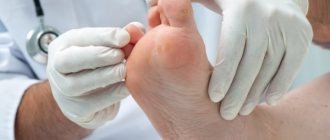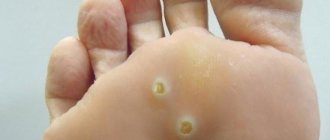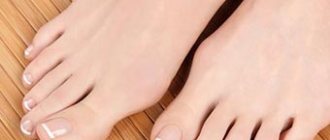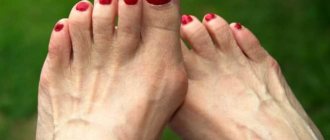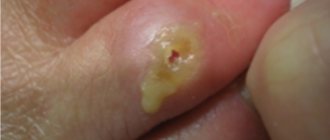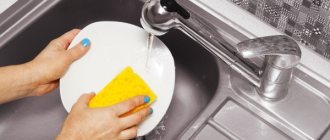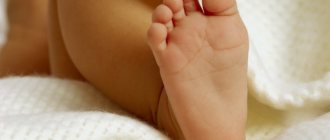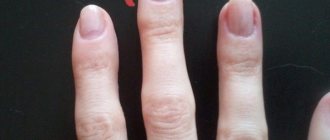Calluses very often affect the feet not only of adults, but also of children. They are usually formed due to excessive friction or strong pressure on a certain area of the sensitive skin of the child’s feet. As a result, this area dies off, and a rough growth forms in its place. A callus on a child’s finger is typically yellow or gray in color and has a lumpy structure. Basically, calluses appear in those places that are actively susceptible to friction.
How to avoid the appearance of calluses on your child’s feet?
- If you decide to go somewhere on a long trip with your child, then it is better not to take shoes that he has not yet worn, since you will often walk with him, and new, unworn shoes can only rub him. It is advisable to have a pair of replacement shoes with you.
- Always buy socks and tights that are the right size (in some cases they can be up to 1 size larger).
- Many pediatricians recommend a special children's massage for the proper development of children's feet, as a method of preventing calluses and other related diseases, which is done over a certain period of time even in preschool age.
Why do children get corns?
Probably every parent knows how difficult it is to choose suitable, comfortable, and high-quality shoes for a child.
Often, mothers and grandmothers buy their child’s shoes “with a reserve” or, on the contrary, just right, without trying them on and not made from real materials. There is no need to do this. All of these factors contribute to the formation of chafing in children.
However, it is worth remembering that even high-quality, well-chosen shoes can rub your feet if they are new.
There is no need to put newly purchased shoes on your child. To begin with, you should distribute them at home, using special products that stretch the skin. For a long walk, it is better for your baby to wear a familiar, well-worn pair.
Formation of corns at a young age
Another reason for the development of calluses in a child is poorly chosen socks or tights. Too thick or thin material, poorly absorbent fabric, as well as tights that gather in folds - all this does not protect children's feet and contributes to the appearance of calluses.
Causes
- Wearing tight shoes.
- Thin sole on the shoe.
- If a child wears shoes without socks, the friction of the foot on the sole increases several times.
- Incorrect or rough seams inside the shoes.
- Socks can not only reduce friction, but conversely, if they are too large, they can cause calluses.
- A callus can form on a young child's toe if he or she walks barefoot too often.
- Playing sports at an early age.
- Wrong walking.
- Calluses can also form if the baby has a congenital predisposition to them (meaning flat feet and bone growths).
How to get rid of heel spurs?
Readers constantly write letters to us with questions: “How to deal with foot fungus?” What to do about unpleasant foot odor? and other pressing questions from our readers' Our answer is simple, there are many folk remedies. But there is also a more effective remedy for fungus ARGO DERM, which doctors have now developed. Actually, A. Myasnikov gave an interview regarding this product, we advise you to read it.
Read…
Types of diseases in which callus appears
There are diseases that can lead to the appearance of core calluses:
- Flat feet. The adaptation of the foot to shoes is disrupted, and formations appear in some areas.
- Osteochondrosis. The limb cannot move normally, and areas of constant stress are more susceptible to calluses.
- Rachiocampsis. The center of gravity shifts to either leg, and due to the increased load, a callus appears.
- Foot injury.
- Obesity or excess body weight.
- Atrophy of plantar adipose tissue.
Treatment of dry and wet calluses
Ordinary dropsy does not require any treatment; parents just need to cover it with a regular bactericidal plaster. If the corn prevents the child from walking and fully standing on his feet, then it must be pierced. Under no circumstances should this procedure be performed at home; it is better to consult a doctor for help. He will prick it with a disinfected needle. Then, the wound is treated with an antiseptic to prevent infection from getting there (the entry of bacteria into a punctured callus leads to the formation of a purulent callus). And finally, the problem area is sealed with an antibacterial bandage. Also, if the dropsy bursts on its own, then simply anoint it with a regular healing cream like Bepanten.
Dry corns are treated somewhat differently and more difficult, since dry corns do not form in one day. Constant friction in the same place first leads to a noticeable thickening of a certain area of the foot, and then the neoplasm begins to grow deep into the tissues themselves.
Types of calluses
There are two main types of calluses:
- Watery callus. It is a bubble filled with liquid. It occurs as a result of friction or prolonged compression of the skin. Liquid (exudate) performs a protective function, protecting injured tissue from infection. There is no need to open a watery callus. If it remains intact, the exudate is transparent, but if the wound becomes infected, the liquid transforms into pus, in which case antibacterial treatment will be required. If the vessels are damaged, the fluid in the callus turns red.
- The dry growth looks like a bump. The growth is hard to the touch, dense and rough. Dry tumors are less common compared to watery ones. The color of the corns can vary from light yellow to pale gray. Structurally, corns are layers of keratinized skin. Such calluses form only on the soles.
Infrequently, core calluses, which are classified as a type of dry neoplasm, are also found in children. The peculiarity of such a callus is that its root grows deep under the skin, which causes pain to the child.
Dry skin can be treated at home
- The most effective way is regular salt baths. The child must support our feet for about 15 minutes, then they are wiped dry and smeared with a rich moisturizer. This procedure takes about a week.
- Special patches with salicylic acid can also help you, but it is recommended to use them extremely rarely, since this acid can not only corrode a dead area of skin, but also a healthy one (therefore, apply such a patch especially carefully).
- As a replacement for salicylic acid, you can use crushed aspirin (it has similar properties).
Mechanical removal (in special medical conditions)
Removal methods:
- Cryodestruction - liquid nitrogen is applied to the callus, after which it freezes and gradually peels off on its own. After exposure, a barely noticeable trace remains, which disappears over time.
- Laser treatment produces a local effect without damaging healthy skin. The core neoplasm is burned out, leaving no traces after such manipulation.
- Electrocoagulation - the growth is gradually destroyed by high-frequency current. The duration of the procedure is no more than 10 minutes. There are no traces left.
- Radio wave treatment - evaporation of the callus along with the core. The method is non-contact and leaves no traces behind.
Traditional medicine as an effective way to combat calluses
- An effective remedy in the fight against corns is onion peel, from which you can prepare a tincture. First of all, the husks need to be poured into a glass container and filled with ordinary vinegar. Let the tincture brew for a week and after this time you can begin to smear the problem area. It is also best to do this procedure directly at night.
- Lemon also works great with calluses in children. Pre-steam your baby's feet and apply a small lemon peel along with the pulp to the area where the callus appears.
- If you have aloe growing at home, it can also be used to treat calluses in children. Cut one leaf in half lengthwise and apply the cut side to the callus, covering it with special compress paper or a regular plastic bag. It is best to do this procedure in the morning.
- A propolis compress also works great against neoplasms. You need to take a little propolis and apply it to the problem area on the skin. Then, the leg is wrapped in a bag, and warm socks are put on top. In the morning, using a regular bath pebble, you can remove rough skin.
Treatment
Which doctor should I contact?
It is not recommended to treat calluses at home, especially when it comes to a child. If such a neoplasm appears, you need to seek qualified help from a specialist.
In the case of watery and dry growths, treatment can be done at home. To combat tumors, both traditional medications and traditional medicine recipes are used. If you decide to be treated at home, it is important not to forget about safety measures so as not to infect the child.
However, the most reliable solution when detecting a callus in a child is to see a doctor. Calluses, like other skin pathologies, are treated by a dermatologist. The specialist will examine the tumor and conduct a differential diagnosis to exclude other types of skin diseases with similar symptoms. For example, the symptoms of a dry growth are similar to the manifestations of a fungus, since with this pathology the skin also thickens. Without special knowledge, parents are simply unable to distinguish a callus from a much more unpleasant problem, which is a fungal infection.
Note! Treatment tactics depend on the type of callus.
Treatment of dry growths
Most often, dry calluses are localized on the foot. Similar calluses also occur on the big toes. The location of these calluses makes them difficult to treat during the daytime, when a person's physical activity peaks. Therefore, the main treatment is carried out at night, and during the day it is recommended to lubricate the problem area with a rich cream to avoid cracking of the skin.
Dry calluses are first softened and then removed. For this purpose, creamy preparations and adhesive plaster impregnated with drugs are used.
The simplest and most accessible drug with keratolytic properties is salicylic ointment. Bensalitin ointment, Super Antimozolin, Lekker-Stopmosol, Salipod and a number of other drugs are also used to treat calluses.
All drugs are applied directly to the callus. Before rubbing the medicine in, it is necessary to steam the skin.
Treatment of watery calluses
Conservative treatment of watery calluses is rarely performed, since the child will almost certainly inadvertently open the wound, and this can lead to infection.
It is not recommended to cut off the skin above the watery callus yourself. The wet callus will be professionally opened by a specialist - a cosmetologist, dermatologist or surgeon. The doctor will treat the wound with an antibacterial composition, lubricate it with medication and apply a bandage.
Further treatment of the child is carried out by the parents at home. Wound treatment is performed 2-3 times a day. At the same time, you should not put pressure on the callus so as not to violate its integrity. Even when the callus opens on its own, it is necessary to preserve a skin flap over it. At home, the callus is treated with salicylic ointment, Compid patch and other drugs recommended by the attending physician.
Treatment of callus
This type of callus is the most difficult to treat. Conservative techniques are the same as in the case of dry growths. However, the greatest effect is achieved by cryodestruction, which consists of freezing the callus. As a result of exposure to cold, the keratinized growth is rejected along with the rod. The technique is completely painless, which is why it is successfully used in the treatment of children.
ethnoscience
There are many remedies from the arsenal of traditional medicine that have proven themselves in the treatment of calluses. All folk methods can be divided into two groups: lotions (compresses) and baths.
Bath recipes:
- Add 2 tablespoons of baking soda and 3 tablespoons of sage to 5 liters of boiling water. Let the mixture sit for 2-3 hours. Before taking the bath, slightly warm the composition. Time for the procedure is 20 minutes.
- Add a tablespoon of baking soda to 1 liter of water. Wash your feet in the mixture using pumice stone. Dry your feet and apply cream to the callus.
- To create this bath you will need a couple of baked onions, which are added to 5 liters of water. The composition is boiled for 5 minutes and then left for half an hour. After straining, steam the callus in the resulting composition.
Lotions recipes:
- To prepare a healing composition, add a fresh chicken egg to the vinegar. Wait until it completely dissolves. Apply the resulting composition to the callus overnight. Apply a warm bandage on top.
- You can soften the skin with aloe. Lightly mash the leaf of the plant to release its juices, and then apply it to the steamed callus. Put on socks or a tight bandage on top.
- Propolis compress. Apply to steamed skin. Do not remove the compress for 2 days.
- Lotion based on onion peels. Add the husks to a container of water. Let the composition brew for 2 weeks. Before applying the peel, lubricate the callus with a thick cream, and then apply a bandage on top. The husk is applied overnight.
- Honey. Apply honey to the callus and then wrap your foot in plastic wrap. Put socks on top and leave the compress until the morning.
Therapeutic measures
- Treatment of non-infected callus. It should be treated with an antiseptic solution in the form of hydrogen peroxide, iodine, brilliant green solution, furatsilin or sodium permanganate solution. Such treatment is necessary to prevent the addition of an infectious agent, which can be streptococcus or staphylococcus. At the end of treatment, it is recommended to cover it with a bactericidal patch or sterile bandage.
From the moment dropsy forms, you should change shoes to more comfortable ones in order to avoid further mechanical impact on the wound.
If further damage to the site is excluded, spontaneous healing is possible within 48-72 hours.
In case of injury to the callus, it is recommended to treat the damaged area with ointments containing antibacterial agents - Levomekol, etc.
- Piercing procedure
A normal, uninfected callus still causes discomfort to a person because it is a protruding formation (especially if on the surface of the heel) and it interferes with wearing shoes. Therefore, it is recommended to undergo a piercing procedure. It can also be carried out at home, however, the rules of asepsis must be observed. It consists of the following manipulations:
- Pre-treatment of the formation and adjacent healthy skin with the antiseptic agents indicated in the previous section.
- Sterilize a sharp piercing object. This can be a sewing needle or pin. Sterilization is carried out by keeping a sharp object in the same solution or in the depth of fire.
- The puncture of the formation itself is carried out almost horizontally, parallel to the plane of the skin, to prevent injury to the day of the dropsy.
- Release the bubble from the liquid contents by pressing on its surface through a sterile napkin (sterile bandages, napkins, etc. are available in the pharmacy chain). In this case, it is strictly forbidden to remove the skin of the bladder.
- Upon completion of the piercing, you should again disinfect the surface of the already collapsed bladder and apply a bactericidal patch or bandage for 24 hours.
If the formation is refilled with liquid contents, the piercing procedure should be repeated.
- Treatment of an infected callus. The addition of a secondary infectious agent is possible if the rules of asepsis during primary treatment or the rules of skin care are insufficiently observed. This is especially true in the summer, when shoes are as open as possible and infection can easily get into the wound surface.
Infection manifests itself in increased pain, hyperemia and an increase in the temperature of the adjacent healthy skin and the occurrence of purulent discharge from the wound. In more severe cases, when large areas are damaged and immunity is reduced, the patient may have an increase in body temperature.
In this case, treatment consists of local use of antibacterial and anti-inflammatory drugs. In case of fever, it is mandatory to go to the appropriate medical institution for medical care, since this is fraught with serious problems.
- Traditional methods. This technique is allowed in the case of a formation not complicated by a secondary infection:
- It is recommended to treat such a pathology on the heel with the help of aloe, Kalanchoe, and plantain. In the first two cases, the cut surface of the plant (pulp) is applied to the damaged heel, in the third - a compress of plantain juice.
- You can apply lemon pulp or peel once a day. This then needs to be secured with adhesive tape.
- To regenerate a burst callus, you can use a decoction of calendula. Before going to bed, take baths and apply calendula-based cream.
- It is recommended to lubricate the damaged area with a mixture of tea tree and vegetable oils in a ratio of 1:3. Frequency: up to 4 times a day.
- Apply potato pulp to the surface of the bladder and secure with a bandage overnight.
When can a bladder be punctured?
If the tumor does not cause any discomfort, it does not need to be opened. If the callus causes pain when walking, then it can be opened. This must be done extremely carefully:
- Wash your hands with warm water and soap.
- Wipe the callus with an alcohol-containing solution or iodine. The same sterilization is necessary for surgical instruments - needles, scissors.
- Make several small punctures in the cavity of the blister. Allow the liquid to drain. Do not remove skin.
- Next, antibacterial ointment is applied to the blister and a gauze bandage is applied.
- When the skin cells die, they are cut off with nail scissors. Antibacterial ointment is applied to the surface of the callus and a new bandage is applied.
If the process of suppuration of the callus has begun, piercing it yourself is strictly prohibited.
Home treatment for water (wet) calluses
Most often, children develop “dropsy” on their legs, which does not require specific therapy. If the blister is small, treat it with an antiseptic and cover it with a bactericidal bandage. If the callus is large and prevents the baby from moving, parents can help the child by carefully opening the blister:
- Clean your hands and needle with disinfectant.
- Make the puncture at an angle of 45 degrees so as not to accidentally injure the internal wound.
- To help the liquid come out faster, you can lightly press down on the blister.
- After the exudate comes out, blot the affected area with a clean gauze cloth.
- Treat the surface with an antiseptic (if the liquid contains pus, apply antibacterial ointment).
- Cover the wound with a bactericidal adhesive bandage.
You can cope with dropsy by applying fresh lemon peel or aloe pulp to it overnight. It is also useful to use laundry soap - soak and treat the callus with it, secure with a bandage. An infusion of chamomile and calendula has a drying effect - just apply it as a lotion to the affected area.
Home treatment for dry chafing
If your baby has corns or dry calluses, do not ignore the problem - despite the fact that these are harmless neoplasms, in rare cases they can degenerate into core growths, which are quite difficult to get rid of.
Before treatment, steam the legs for 20 minutes in a warm bath of decoction of birch leaves, calendula, sage, mint, chamomile or burdock root. Then remove the softened layer of corns with a soft pumice stone, apply baby cream to the feet and put on cotton socks (let the baby sleep in them all night).
In addition to baths, you can use the following products to soften dry calluses:
- propolis - apply under a bandage and leave for 10-12 hours;
- vegetable oil (any) - rub your legs with it at night, wrap it in plastic on top, put on socks;
- compresses - grind potatoes, onions, aloe (all in equal quantities), mix and apply to the affected area under a bandage for 6-8 hours;
- onion peel, infused in vinegar for 14 days, softens the keratinized layers of the corn - apply the product under the bandage, having previously treated the skin around the growth with cream or Vaseline;
- lemon pulp - applied over the callus, fixed with a bandage, and left overnight.
Usually, such manipulations allow you to get rid of dry calluses in a short time, but if this does not happen, the doctor may recommend using pharmaceutical drugs.
Medications
To eliminate corns, drugs with keratolytic action are used - they soften the keratinized layers of the skin, after which they can be easily removed with ordinary pumice. Before using such drugs, steam your feet in a decoction of herbs, dry them with a towel and apply the medicine.
Salicylic ointment helps soften the growth; it is applied to the entire surface of the corn (trying to avoid contact with healthy skin), and allowed to absorb a little.
After 15 minutes, apply bactericidal Tebrofen ointment and allow to dry. The manipulation is repeated twice a day.
The Collomac solution is applied dropwise (for children, the maximum allowable dosage is 1 ml per day) onto a pre-steamed callus twice a day. The duration of treatment does not exceed a week.
Keratolytic patch Salipod (has a bactericidal and softening effect). Apply the product to steamed and dried corns and wear for two days. Afterwards, remove the patch and remove the softened layer of skin. If one procedure is not enough, the manipulation is repeated.
In the case of the formation of core calluses (which rarely happens in children), mechanical removal of the growth is carried out.
Always remember!
- If your attempts to open the wet callus are unsuccessful, if it bleeds or separates;
- If the process does not improve during your treatment (is not resolved);
- If the pain is severe and prevents you and your child from doing their normal activities
Contact your doctor!
Precautionary measures
Calluses on the feet are easy to prevent. The main thing is to remove the cause. Simple rules will prevent the development of corns:
- Properly selected shoes will solve the problem by 70%. You can't buy shoes that are too small or too big. There should be half a centimeter between the big toe and the beginning of the shoe;
- Families with many children should remember that younger children should not carry their children to term after their older ones. Poor quality shoes bend and become deformed. It will be difficult for the baby to walk in it. If the older one had flat feet or other deformities, then the younger one will inherit everything. A child's foot is a plastic material. It easily changes shape from uncomfortable, tight shoes. Over time, corns and flat feet form, subsequently scoliosis, lordosis;
- shoes made from natural materials will breathe. The foot does not sweat - there are no calluses;
- young athletes need to change their shoes every six months. It is recommended to consult a doctor to select special insoles for children;
- Excess weight puts high pressure on the foot, causing calluses to form. The pediatrician will determine what the problem is: disruption of the body’s systems or banal overeating;
- dry socks will protect against friction;
- buy your children not heavy, thick shoes;
- teach your child to perform daily hygiene procedures: take a bath, use a pumice stone, wipe your feet dry;
- Socks and tights must be the right size and not slip down.
httpv://www.youtube.com/watch?v=embed/lIzFRyeLFXY
